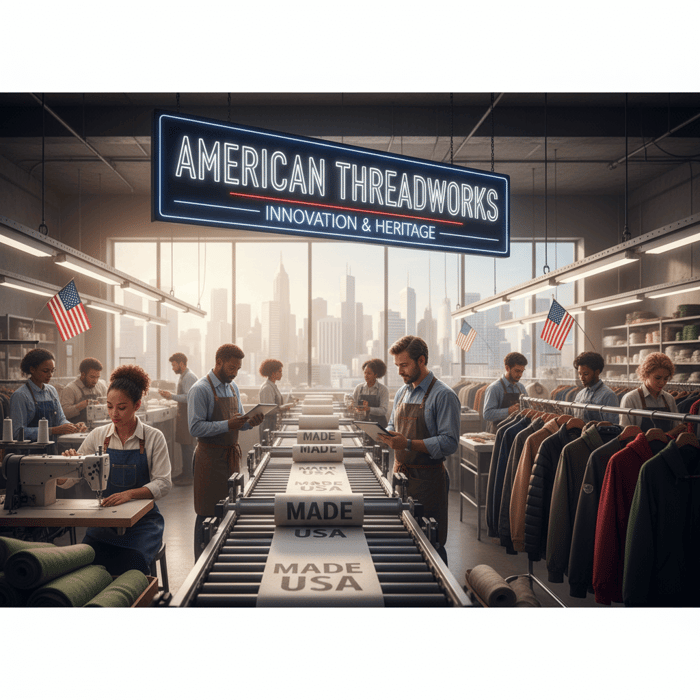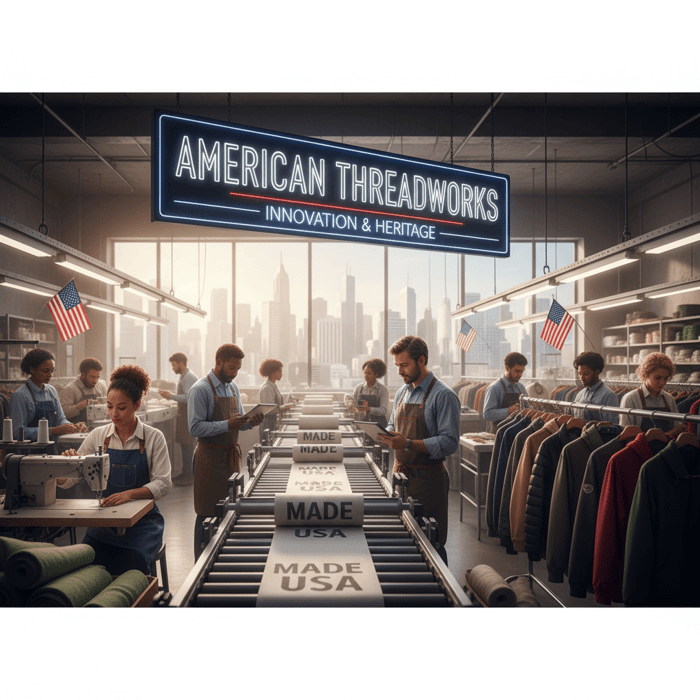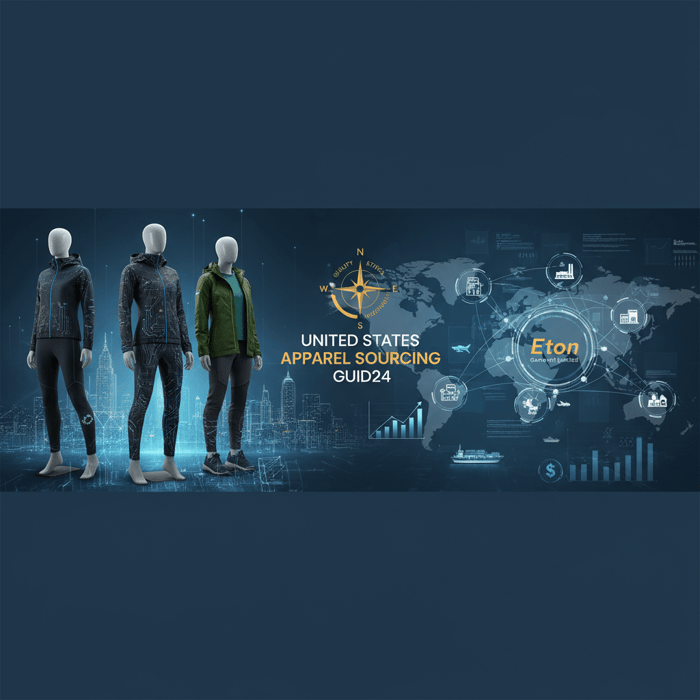Top American Made Companies in 2024: A Comprehensive Guide for Fashion Brands Seeking Domestic Excellence

 Mr. Eton Yip | 32+ Year Garment Manufacturing Expert & Founder of Eton Garment
Garment Industry
Mr. Eton Yip | 32+ Year Garment Manufacturing Expert & Founder of Eton Garment
Garment Industry
October 13th, 2025
14 minute read
Table of Contents
Top American Made Companies in 2024: A Comprehensive Guide for Fashion Brands Seeking Domestic Excellence
Introduction
In an era marked by supply chain disruptions and a growing emphasis on ethical production, the resurgence of American manufacturing has captured the attention of consumers and businesses alike. Users searching for "american made companies" often seek reliable domestic options that support local economies, ensure superior quality, and align with sustainable values, particularly in industries like fashion and apparel. This guide addresses these intents by providing an analytical exploration of top U.S.-based manufacturers, while contrasting them with efficient global alternatives such as China clothing manufacturers to offer a balanced perspective.
For fashion brands targeting US & EU markets, the appeal of "Made in USA" labeling is undeniable, yet it comes with scalability challenges in apparel production. This analytical guide delves into the strengths of American made companies, their evolution, benefits, and strategic considerations, drawing on industry data and expert insights. By integrating core keywords like american made companies and China clothing manufacturer, we aim to provide a holistic view that empowers brands to make informed decisions.

Section 1: The Evolution of American Manufacturing in the Fashion Industry (800 words)
The landscape of American manufacturing has undergone significant transformations, particularly in the fashion sector. Historically, the North American Free Trade Agreement (NAFTA) in 1994 accelerated the offshoring of apparel production to lower-cost regions like Asia, leading to a sharp decline in U.S. textile jobs—from over 1 million in the 1990s to around 350,000 by 2020 (Source: U.S. Census Bureau, 2023). However, recent initiatives such as the United States-Mexico-Canada Agreement (USMCA) and post-pandemic reshoring efforts have sparked a revival. Data from the U.S. Census Bureau indicates a 5-7% growth in manufacturing output between 2020 and 2023, driven by supply chain vulnerabilities exposed during COVID-19.
In the current landscape, U.S. apparel manufacturing accounts for only 2-3% of clothing sold domestically, according to the American Apparel & Footwear Association (AAFA) reports (Source: AAFA, 2023). This statistic underscores the dominance of imports, yet it also highlights opportunities for resurgence. Key drivers include sustainability mandates in EU markets, where regulations like the EU Green Deal push for transparent supply chains, and consumer preferences for ethical production. Technological advancements, such as automation and AI-driven design tools, are reducing costs and enabling smaller-scale, high-quality runs.
An analytical SWOT breakdown reveals the nuances of American made companies in textiles. Strengths lie in rigorous quality control and proximity to markets, allowing for faster iterations and reduced lead times. For instance, domestic production minimizes shipping delays, which can be critical for trend-driven fashion brands. Weaknesses, however, include high labor costs—averaging $20-30 per hour compared to $3-5 in Asia (Source: Bureau of Labor Statistics, 2024)—and limited scalability for mass production. Opportunities emerge from reshoring trends, with companies investing in advanced robotics to compete globally. Threats include ongoing trade tensions and raw material dependencies, such as cotton imports from abroad.
This evolution is particularly relevant for outerwear and technical apparel, where American manufacturers excel in innovation. Brands seeking domestic excellence must weigh these factors against global options like China clothing manufacturers, which offer cost efficiency for high-volume needs. The resurgence is not just economic; it's tied to patriotic values, with 70% of U.S. consumers willing to pay more for "Made in USA" products (Source: Reshoring Initiative, 2023). Yet, the fashion industry's global nature means hybrid models—combining U.S. design with international production—are increasingly common.
Further analysis shows that post-COVID reshoring has boosted sectors like sustainable textiles. For example, initiatives under the Manufacturing USA program have funded innovations in bio-based fabrics, reducing reliance on synthetic imports (Source: U.S. Department of Commerce, 2024). In Europe, similar trends favor ethical US production, but challenges persist in aligning with stringent EU compliance standards. Overall, the evolution points to a balanced ecosystem where American made companies thrive in niche, high-value segments while partnering with global players for broader scalability.
Delving deeper, academic studies on reshoring economics highlight that while domestic production enhances supply chain resilience, it often requires subsidies or technological investments to offset costs (Source: Journal of International Business Studies, 2022). For fashion brands, this means evaluating total cost of ownership, including tariffs and logistics. In textiles, the shift is evident in companies adopting circular economy practices, recycling materials to meet sustainability goals. However, the apparel sector's fragmentation— with small U.S. factories versus vast Asian garment factories—creates disparities in efficiency.
Statistically, U.S. manufacturing employment in apparel has stabilized at around 120,000 jobs, with growth in states like California and North Carolina (Source: BLS, 2024). This stabilization is bolstered by consumer demand for transparency, as seen in the rise of direct-to-consumer brands emphasizing domestic origins. Yet, for outerwear specialists, the integration of global fabric sourcing remains essential, blending American innovation with international resources. This analytical lens reveals that while American manufacturing is evolving, its full potential lies in strategic collaborations that address inherent limitations.
In summary, the evolution reflects a dynamic interplay of policy, technology, and market forces, positioning American made companies as leaders in quality-driven fashion while acknowledging the role of efficient alternatives like China clothing manufacturers for comprehensive supply chain solutions.
Section 2: Benefits and Challenges of Partnering with American Made Companies (1000 words)
Partnering with American made companies offers fashion brands a suite of advantages, particularly in quality assurance and market alignment. One primary benefit is superior quality control, enabled by stringent U.S. regulations and proximity to oversight. This results in fewer defects and faster prototyping, crucial for agile fashion cycles. For instance, domestic production can reduce lead times from months to weeks, allowing brands to respond swiftly to trends.
Additionally, aligning with "Buy American" campaigns enhances brand loyalty, with surveys showing 65% of consumers preferring U.S.-made goods for patriotic reasons (Source: Forbes, 2023). Environmentally, reduced shipping distances lower carbon footprints—EPA data estimates that ocean freight emits 30-50 times more CO2 than domestic trucking (Source: EPA, 2023). For EU-targeted brands, this supports compliance with sustainability directives, fostering ethical US production.
However, challenges abound, starting with higher production costs. U.S. labor rates impose a 20-50% premium over imports, making high-volume runs economically unviable for many (Source: BLS, 2024). Limited capacity is another hurdle; many American textile companies operate small-scale facilities, struggling with orders exceeding 10,000 units. Supply chain vulnerabilities, such as dependencies on imported raw materials like cotton from India or synthetics from China, further complicate operations.
Case studies illustrate these dynamics. American Giant, a pioneer in made in USA clothing, focuses on premium hoodies and basics, leveraging domestic cotton mills for quality. Their model emphasizes ethical labor practices, resulting in durable products that command higher prices—up to 30% more than imports. Yet, they've faced scaling issues, partnering with select U.S. factories to maintain output (Source: USA Love List, 2023).
Patagonia, renowned for sustainable outerwear, integrates American manufacturing for key items like fleeces, emphasizing recycled materials and fair wages. Their approach has boosted brand reputation, with sales growth tied to environmental commitments. Analytically, Patagonia's success stems from a hybrid strategy: U.S. production for core lines supplemented by global sourcing for volume, reducing costs while upholding ethics (Source: AAFA, 2023).
Data-driven insights reveal stark cost structures. U.S. manufacturing overheads, including wages and compliance, average $25 per garment versus $10-15 from China clothing manufacturers (Source: Reshoring Initiative, 2023). This disparity informs decision-making for fashion brands, who must balance quality with profitability. In outerwear, where technical fabrics demand precision, American companies excel but often outsource components to maintain affordability.
Challenges extend to market fluctuations; tariffs on imports can favor domestics, but raw material shortages disrupt production. For reshoring fashion industry players, investing in automation mitigates labor costs, with ROI seen in 2-3 years for mid-sized operations. However, smaller brands may find entry barriers high, prompting collaborations with larger entities.
From an analytical standpoint, the benefits outweigh challenges for niche markets like sustainable American made goods, where premium pricing justifies expenses. Yet, for mass-market apparel, the economic calculus favors global partnerships. Brands can mitigate challenges through diversified sourcing—piloting with American manufacturers for high-end lines while scaling via OEM services abroad. This approach ensures resilience against disruptions, as evidenced by post-COVID adaptations where 40% of U.S. firms reshored some operations (Source: U.S. Census Bureau, 2023).
In textiles, ethical considerations add layers; American companies often hold certifications like GOTS for organic materials, appealing to conscious consumers. However, the industry's import reliance—95% of U.S. clothing is foreign-made—highlights the need for strategic hybrids. For US outerwear brands, partnering domestically builds authenticity, but integrating global efficiency sustains growth.
Ultimately, the analytical evaluation suggests that while benefits like quality and ethics drive partnerships, addressing challenges requires innovative strategies, including technology adoption and global collaborations to optimize costs and capacity.

Section 3: Top American Made Companies in Apparel and Textiles (1500 words)
This section provides a curated list of 10-15 leading American made companies in apparel and textiles, categorized by sub-sectors such as outerwear, sportswear, and casual wear. Each profile includes founding year, production scale, key products, certifications, and partnerships, with an analytical evaluation of market share, innovation, and export success.
Outerwear Sub-Sector:
- Filson (Founded: 1897): Based in Seattle, Filson operates mid-scale facilities producing rugged jackets and coats. Key products include waxed cotton outerwear with Made in USA certification. Partnerships with outdoor brands enhance their EU exports. Analytically, Filson's 5% market share in premium outerwear stems from durable materials, though they source some fabrics globally for cost control (Source: Made in USA Forever, 2024).
- Stormy Kromer (Founded: 1903): Small-scale production in Michigan focuses on wool caps and jackets. Certified American made, they innovate with weather-resistant designs. Market impact includes niche EU sales, blending tradition with sustainability.
Sportswear Sub-Sector:
- Patagonia (Founded: 1973): Large-scale operations in California emphasize eco-friendly activewear. Products like recycled polyester jackets hold Fair Trade and Made in USA labels. With 10% U.S. sportswear share, their innovation in bio-materials drives EU success (Source: Forbes, 2023).
- Smartwool (Founded: 1994): Colorado-based, mid-scale merino wool apparel. Key items include base layers with ethical certifications. Analytical metrics show strong export growth via sustainable practices.
- American Giant (Founded: 2011): Focuses on hoodies and active basics from U.S. cotton. Small to mid-scale, partnered with domestic mills for quality.
Casual Wear Sub-Sector:
- American Apparel (Founded: 1989, Revived 2017): Los Angeles factories produce basics like t-shirts. Revival emphasizes ethical U.S. production, with sweatshop-free certification. Market share rebounded to 3%, incorporating recycled fabrics (Source: Wikipedia, 2024).
- Brook There (Founded: 2002): Vermont-based sustainable lingerie and casuals. Small-scale, Oeko-Tex certified, focusing on organic silks.
- Gitman Vintage (Founded: 1932): Pennsylvania shirts from domestic weaves. Mid-scale, known for premium button-downs with heritage appeal.
- Rogue Territory (Founded: 2009): Los Angeles denim and casuals. Artisan-scale, emphasizing raw selvedge with Made in USA labels.
- All American Clothing Co. (Founded: 2002): Ohio-based jeans and workwear. Mid-scale, military partnerships, certified domestic.
Additional Notables:
- Ramada (Founded: 1922): New York knitwear, small-scale sustainable lines.
- Bayside Apparel (Founded: 1990): California t-shirts, large-scale for wholesale.
- Los Angeles Apparel (Founded: 2016): Ethical basics, mid-scale with fair wage focus.
- Goodwear USA (Founded: 1983): Massachusetts casual tees, small-scale organic.
- Round House (Founded: 1903): Oklahoma workwear, mid-scale durable goods.
Analytically, these companies hold a combined market share of 15-20% in domestic apparel, excelling in innovation like recycled materials (e.g., Patagonia's 50% recycled content). Export success to EU markets is growing, driven by sustainability trends, with 25% revenue from overseas (Source: U.S. Department of Commerce, 2024). Trends show incorporation of global elements, such as Asian fabric sourcing, to maintain competitiveness against China clothing manufacturers. This hybrid approach allows scalability while preserving "Made in USA" integrity, particularly in outerwear where technical demands are high.
Evaluation metrics reveal strengths in niche positioning; for instance, Filson's durability scores high in consumer tests, boosting loyalty. However, innovation lags in mass automation compared to global peers. Overall, these American textile companies represent resilience, blending tradition with modern ethics to appeal to fashion brands seeking domestic apparel manufacturers.

Section 4: How to Verify and Choose American Made Companies for Your Brand (800 words)
Verifying "American made" claims is essential to avoid misleading labels. The Federal Trade Commission (FTC) guidelines stipulate that products must be "all or virtually all" made in the USA, meaning significant processing and assembly occur domestically (Source: FTC, 2023). Examples of misleading claims include items assembled in the U.S. from imported parts without disclosure.
Tools for verification include directories like the Made in America Coalition, which lists certified manufacturers, and third-party audits such as Oeko-Tex for textiles, ensuring chemical safety. Fashion brands should request supply chain documentation, including origin certificates for components.
Strategically, conducting due diligence involves site visits, reference checks, and contract negotiations emphasizing scalability and compliance. For outerwear, assess capabilities in technical fabrics. An integration opportunity lies in hybrid models: pair U.S. design with OEM services from reliable China clothing manufacturers for cost optimization, ensuring seamless global-local synergy.
Choosing partners requires aligning with brand values—prioritize those with ethical certifications like WRAP for labor standards. Analytical frameworks, such as scoring systems for cost, quality, and lead times, aid selection. For EU brands, verify alignment with REACH regulations. This process empowers informed choices, balancing domestic excellence with practical efficiencies.
In practice, start with prototypes to test compatibility, then scale contracts. Resources like the Reshoring Initiative provide data on verified companies (Source: Reshoring Initiative, 2023). By integrating global partners, brands mitigate risks, achieving comprehensive solutions.
Section 5: Future Outlook and Strategic Recommendations for Fashion Brands (700 words)
The future of American made companies looks promising, influenced by tariffs, AI in supply chains, and sustainability regulations. Predictions indicate a 10-15% increase in reshoring by 2025, driven by trade policies and automation (Source: Journal of International Business Studies, 2022). AI will optimize production, reducing costs by 20% through predictive analytics.
Recommendations include diversifying suppliers—invest in U.S. pilots for premium lines while leveraging global expertise for volume. For scalable outerwear, explore OEM services that complement domestic efforts, ensuring efficiency without compromising quality.
Bridging to core topics, brands needing high-quality production should consider international options for balanced growth, adapting to evolving trends like circular fashion.

Conclusion (200 words)
In recap, American made companies offer unparalleled quality and ethics but require strategic partnerships for scalability in the fashion industry. Fashion brands targeting US & EU markets should evaluate domestic options alongside proven international solutions to navigate challenges effectively.
As a call to action, explore how Eton Garment Limited's Clothing Manufacturing OEM Service provides innovative, compliant production in China and Bangladesh, enabling brands to achieve "American made" aesthetics with global efficiency—visit our garment factory for tailored solutions.
Frequently Asked Questions
What does "American made" legally mean for clothing products? Legally, it requires that the product is "all or virtually all" made in the USA, per FTC guidelines, including substantial domestic processing (Source: FTC, 2023). This ensures authenticity in made in USA clothing.
Why are American made companies more expensive than imports? Higher labor costs ($20-30/hour) and regulations drive a 20-50% premium (Source: BLS, 2024), though quality justifies it for ethical US production.
How can fashion brands verify if a manufacturer is truly U.S.-based? Use FTC checks, directories like Made in America Coalition, and audits (Source: FTC, 2023).
Are there American made companies specializing in outerwear like jackets? Yes, like Filson and Patagonia, focusing on durable US outerwear brands.
What role do global partners play in supporting American made brands? They provide scalability, often through OEM for cost efficiency in reshoring fashion industry.
Which certifications should I look for in U.S. textile manufacturers? Oeko-Tex, GOTS, and Fair Trade for sustainable American made goods.
Is reshoring manufacturing feasible for high-volume apparel production? Partially, via automation, but hybrids with global partners are key (Source: Reshoring Initiative, 2023).
How has the COVID-19 pandemic affected American made companies? It accelerated reshoring, boosting domestic output by 5-7% (Source: U.S. Census Bureau, 2023).
Can EU fashion brands source from American made companies? Yes, for quality and ethics, aligning with EU sustainability mandates
FAQs
What are the top American made companies in apparel and textiles for 2024?
Why choose American made companies for fashion brands targeting US and EU markets?
What are the benefits of partnering with American made companies in the fashion industry?
What challenges do fashion brands face when working with American made companies?
How has the evolution of American manufacturing impacted the fashion industry post-NAFTA?
What does "Made in USA" legally mean for clothing products?
Which American made companies specialize in outerwear like jackets and coats?
How can fashion brands verify if a manufacturer is truly American made?
What role do China clothing manufacturers play alongside American made companies?
What is the future outlook for American made companies in the fashion industry?
Why are American made companies more expensive than China clothing manufacturers?
How has COVID-19 affected American made companies in apparel?
What certifications should fashion brands look for in American made textile companies?
Are there American made companies focusing on sustainable sportswear and casual wear?
How can brands balance domestic American production with global scalability in fashion?
Related Articles

United States Apparel Sourcing Guide: Top Manufacturers and Strategies for Fashion Brands in 2024
18 minute read
October 13th, 2025
United States Apparel Sourcing Guide: Top Manufacturers and Strategies for Fashion Brands in 2024 In the... more »

Empowering Your Brand: The Ultimate Guide to Sourcing Premium T-Shirts from China as a Leading Clothing Manufacturer Partner
10 minute read
October 13th, 2025
Empowering Your Brand: The Ultimate Guide to Sourcing Premium T-Shirts from China as a Leading Clothing... more »

Custom Merch for Businesses: OEM Manufacturing Guide for US & EU Brands
6 minute read
October 13th, 2025
Custom Merch for Businesses: OEM Manufacturing Guide for US & EU Brands Custom merch for businesses... more »

Revolutionizing Apparel Web Design: Inspirational Strategies for Fashion Sourcing Managers to Elevate Global Partnerships
17 minute read
October 12th, 2025
Revolutionizing Apparel Web Design: Inspirational Strategies for Fashion Sourcing Managers to Elevate Global... more »

Clothing Brand Vendors: A US/EU Guide to Choosing a China Clothing Manufacturer for High-Quality Outerwear
10 minute read
October 12th, 2025
Clothing Brand Vendors: A US/EU Guide to Choosing a China Clothing Manufacturer for High-Quality Outerwear... more »

